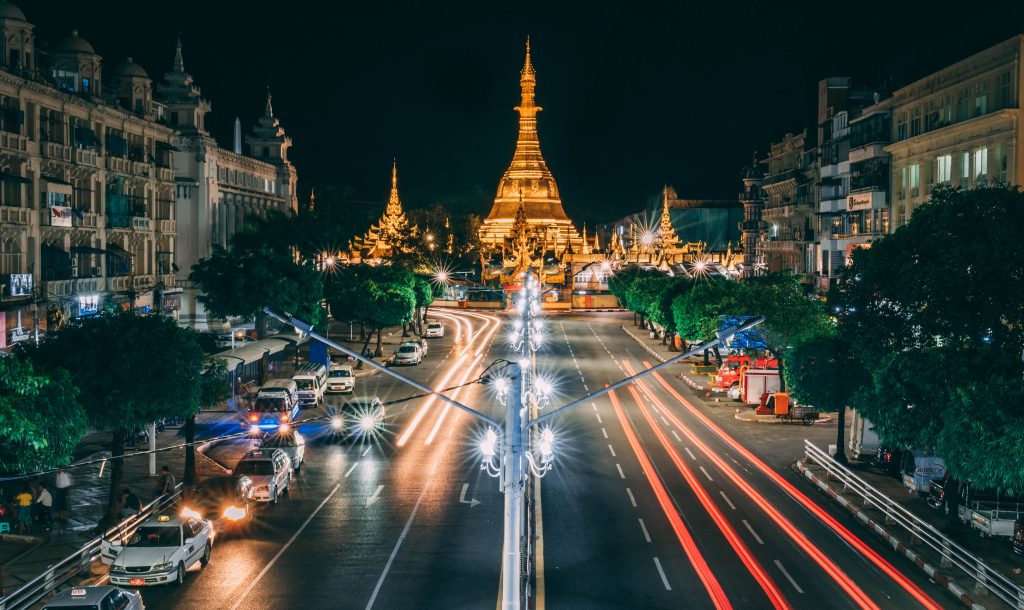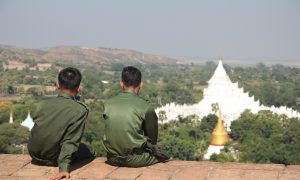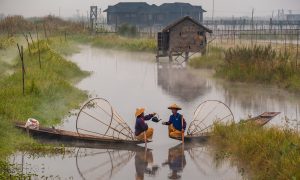Embroiled and engrossed in Myanmar’s many, seemingly intractable problems – which are regularly internationalised – people may have fallen into a ‘distraction’ trap. It is undeniable that this divided, even fractured, country is in bad shape – definitely more so since the 2015 elections. With the opening of a new counter-insurgency front in Rakhine State, the chances for a broad peace settlement plummeted further. The rift in the state, the differences over constitutional amendment, a re-centralised government and ineffectual parliament both beset by paralysis: these have all focused and exasperated public attention. In addition, leadership failure over the Rohingya crisis has now led to a lawsuit at the ICJ.
The ‘problem overload’ which is of the government’s own making, is enough to put other issues in the shadows. In most matters in Myanmar, there is one country that is close by, in one form or another, and that is China. The Chinese presence and footprint are growing, especially the non-state part. The Belt and Road Initiative (BRI) and its component Corridor are the subject of much analysis. This is where the distraction comes in. With all the present preoccupation with the inroads and encroachments from China (which, by the way, are very real) we may be missing the real impetus, direction and motivation behind China’s so-called ‘grand design’.
Going through the numerous reports and studies on this, what I find most plausible are that firstly, BRI incorporates pre-existing Chinese investment projects. Although the more recent articulation of the BRI makes it look like a state-driven programme, it is not wholly so. Right now, Chinese provinces are vying for expanded investments in Myanmar. To them the maxim is ‘more and bigger are better’. The central state only regulates it; this is one reason responses to BRI abroad vary so much.
The other overarching rationale behind BRI is China’s imperative to break out of what it sees as US encirclement. When I first heard the word ‘containment’ from academics in China, I was surprised since this is no longer the Cold War era. But sadly, those concepts remain, albeit under different names.
In both instances, there is also the involvement of the Chinese public and public sentiment. This has not been given its due, accustomed as we are to stereotypes of people living under an authoritarian system, who are not generally known to speak out. However, Chinese citizens are now expressing themselves in an unprecedented way, with the help of social media platforms. To give one example, when the construction of the Myitsone Dam was suspended in 2011, the Chinese government hardly raised a voice of protest (although inwardly it was seething). The uproar came on social media, most of it directed against Myanmar. Scholars at Chinese think tanks mentioned this, but only in private. The sentiments expressed on social media saw the breach of contract as an affront to China. The State monitors social media closely.
When President Xi Jinping started to consolidate his power, he made regular references to China regaining its status as a leading world power and the ‘China Dream’. It needs to be said here that China is not alone in resorting to populism and deeply embedded attitudes expressed as ethno-nationalism. Democracies are definitely not immune to this – the name might become majoritarianism, but the principle is the same.
Hence, if Chinese (Han) nationalism is so rampant, we should look at how non-Han people fare in China. The minorities with the biggest populations and territories are the Uyghurs and the Tibetans. For decades the world has known how the Tibetan people and their culture are treated. Recently there has been a deluge of disturbing information on the treatment of the Uyghurs. State policy changes this year point towards ending preferential treatment for minorities and stepping up cultural – and even biological – assimilation. In most cases having a Han name and speaking Mandarin is the only way to get ahead, as a young man in Nanning who admitted he is from the Zhuang minority said to me.
So, the question that lies at the heart (of BRI too) of this all is: how will people in neighbouring countries be regarded? Several scholars have begun to ask whether the concept of Westphalian sovereignty applies to Asia, especially now with so much asymmetric power dynamics. There are new perspectives on concepts and practices from antiquity, such as the tribute system and tian chia (China’s ‘all under heaven’). Two countries in mainland Southeast Asia have been problematic for China – Myanmar and Vietnam. Both have strong nationalisms historically and traditionally (the majority nationalism being a source of conflict for Myanmar). There is the possibility that Myanmar (Bamar) and Chinese (Han) nationalisms could meet head-on.
However, Vietnam and Myanmar’s ‘approaches’ to China are quite different. Vietnam has longer cultural and historical ties to China, but present-day relations are riven by tension. Besides being more ethnically diverse, Myanmar shows significant differences regarding how state actors and society interact with China. The Myanmar leadership tends to see China as a means of furthering their personal and institutional ambitions. In a setting marked by government opacity, civil society has been the watchdog keeping tabs on Chinese inroads. (There is a constant litany from China that Western agency is behind this civil society ‘troublemaking’. Members of local civil society resent this very much).
Data from a recent survey by ISEAS illustrate these points. The question posed was, “How do you view China’s re-emergence as a major power with respect to Southeast Asia?”. Vietnamese responses took a pronounced, harder line compared to those from other countries, with the majority characterizing China as a “revisionist power”. Responses from Myanmar were more evenly spread, showing that opinions are more divided on China.
Is a weak USDP good for Myanmar?
Authoritarian successor parties can be an important part of democratic consolidation, so we shouldn’t necessarily welcome a weak USDP.
The results for Myanmar bring out the breadth of public opinion that is not reflected in the national government and Parliament. Because of the NLD’s overwhelming majority in Parliament, other parties including ethnic-nationality parties are marginalised. On the important issue of Chinese investments, practically all decisions are made by the central (NLD) government. Lawmakers at the sub-national level have complained about this.
It must also be remembered that the external manipulation of elections and other democratic processes is now widespread. If it happens in Washington and in Westminster, why not in Myanmar?
Stepping Up the Belt and Road
| < MOST IN FAVOUR LEAST IN FAVOUR > | ||||
| Ethnic armed organizations, particularly UWSA/Northern Brotherhood
|
China-linked businesses, and regional governments with which they are heavily involved | Incumbent National League for Democracy government | Central military | Majority of CSOs, incl. environmental movement, ethnic-cased civil society |
Attitudes Toward the Belt and Road Initiative Among Domestic Stakeholders
As to domestic attitudes towards the Belt and Road Initiative, this table lays out the gradations in views among the major stakeholders. The ethnic armed organisations are obviously closest to China in many respects and thus favour the BRI the most. At the other end are civil society organizations that are more worried about China’s growing ‘footprint’.
A very pertinent starting question would be: if there are supposed benefits for Myanmar, how will these be shared? Vertically (between strata) and horizontally (between sub-national entities and ethnicities). How will it impact upon the ending of the civil war and the hoped-for federal system? How will it affect the regional balance of power? It is a matter of some doubt whether these, and similar concerns, are even being considered in the halls of Naypyidaw. On the China-Myanmar Economic Corridor as well as in other spheres, a more consultative, inclusive and participatory approach is urgently required. What is involved is more than just about overcoming crises and the prospects at the next elections in 2020. It is ultimately directed towards building a viable, plural and federalist democracy, alongside a more equitable and tolerant society.
The degree of mistrust towards China’s intentions is high, and its public relations are poor. One key ‘deliverable’ will be the degree and nature of traction it has with the Myanmar military. And when all is done, what will be China’s ‘value-added’ on Myanmar? This storyline will stretch over several years and it will be messy and truncated. Remember that the MoU has only set things in motion; there is much more along the way that can and will happen.
Most of the attention on China is towards the big-ticket infrastructure projects. But at the same time, the ‘small fry’ from China are all over the country now, especially after the easing of visa requirements. This resembles Chinese population incursions into the Russian Far East. Chinese investors, both big and small, may have decided to opt for a more dispersed ingress into Myanmar. One recent middle-size development is the new town of ShweKokko on the Thai-Myanmar border in Kayin state. It is a collaboration between a Kayin militia and a Chinese developer. Whether this represents a natural process or a slow swallowing by a pythonic entity is open to debate.
With Chinese citizens who are now in Myanmar for one reason or another, there are dozens – if not hundreds – of minor irritant cases not big enough to cause major consequences. However, cumulatively they could become a powder keg waiting for a spark. Hlaing Tharyar, the township across the Hlaing River from Yangon, has become the favoured location for ‘new’ Chinese, and a prime candidate for combustibility.
(Limited) Prescriptions
This engagement with China has become a vehicle that brings out the flaws and failings of Myanmar’s politics and government. It should be abundantly clear by now that a centralised form of government, whether military or civil, has not worked in Myanmar. Nor is a tentative federal system the easy answer, as many see it. While federalism has ‘come out into the open’, the risks have also increased. Only the back-and-forth and cut-and-thrust of open deliberative processes can bring the resultant outcomes that are needed, not least to relation to decisions about China. Yes, it will be messy, but with a positive messiness – instead of the present toxic one.
 Facebook
Facebook  Twitter
Twitter  Soundcloud
Soundcloud  Youtube
Youtube  Rss
Rss 



